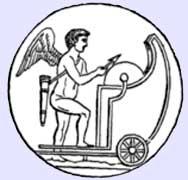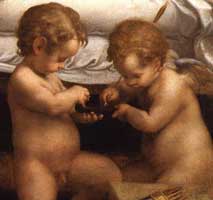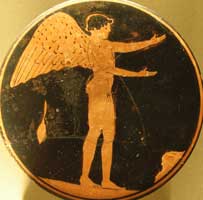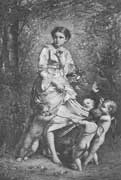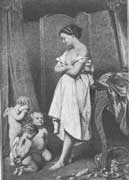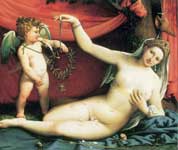.
Ἔρως ἀνίκατε μάχαν, Ἔρως, ὃς ἐν κτήμασι πίπτεις,
ὃς ἐν μαλακαῖς παρειαῖς νεάνιδος ἐννυχεύεις,
φοιτᾷς δ' ὑπερπόντιος ἔν τ' ἀγρονόμοις αὐλαῖς·
καί σ' οὔτ' ἀθανάτων φύξιμος οὐδεὶς
οὔθ' ἁμερίων σέ γ' ἀνθρώπων. ὁ δ' ἔχων μέμηνεν.
O Eros, the conqueror in every fight,
Eros, who squanders all men’s wealth,
who sleeps at night on girls’ soft cheeks,
and roams across the ocean seas
and through the shepherd’s hut—
no immortal god escapes from you,
nor any man, who lives but for a day.
And the one whom you possess goes mad. Sophocles, Antigone
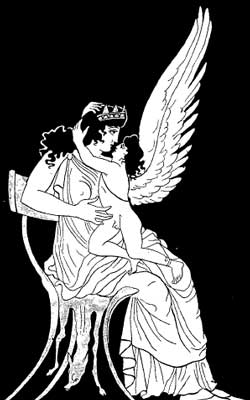
Eros embraces a woman, from a Greek vase painting (part of the Hope Collection, Deepdene)
|
Eros whetting his darts |
In Greek mythology, Eros ( Ἔρος ) was the god responsible for lust, love, and sex; he was also worshipped as a fertility deity. His name is the root of words such as erotic. His Roman equivalent was Cupid, "desire", also known as Amor, "love". He was often associated with Aphrodite. He was, like Dionysus, sometimes referred to as Eleutherios, "the liberator".
Conceptions of Eros
Throughout Greek thought, there appear to be two sides to the conception of Eros; in the first, he is a primeval deity who embodies not only the force of erotic love but also the creative urge of ever-flowing nature, the first-born Light that is responsible for the coming into being and ordering of all things in the cosmos. In Hesiod's Theogony, the most famous Greek creation myth, Eros sprang forth from the primordial Chaos together with Gaia, Erebus, and Tartarus, the underworld; according to Aristophanes' play The Birds, he burgeons forth from an egg laid by Night conceived with Darkness. In the Eleusinian Mysteries, he was worshipped as Protogonus, the first-born.
Alternately, later in antiquity, Eros was the son of Aphrodite and either Ares or Hephaestus, or of Porus and Penia, or sometimes of Iris and Zephyrus; this Eros was an attendant to Aphrodite, harnessing the primordial force of love and directing it into mortals, an apt role for the issue of a union between "Love" and either "War" or "Fire." In some myths, he is portrayed as being playful, frequently causing trouble for gods and mortals; in others, he is mindful of the power he wields, sometimes refusing the entreaties of his mother and other gods to interfere in the course of some mortals' lives. In some versions he had brothers named Anteros, the embodiment of unrequited love, and Himerus.
In art, Eros was usually depicted as a winged young boy or infant, with his bow and arrows in hand. He had two kinds of arrows: one was golden with dove feathers that caused instant love; the other was lead with owl feathers that caused indifference. The poet Sappho described him as "bittersweet" and "cruel" to his victims; he was also unscrupulous, mischievous and charismatic. In his ancient identification with Protogones and Phanes he was adorned represented as a bull, a serpent, a lion, and with the heads of a ram.
But of course Eros is not always perceived as a child; that was more of "Cupid" based off the Roman belief system. In the Greek religion he was a young man; a teenager as opposed to a baby in a diaper.
Worship of Eros was uncommon in early Greece, but eventually became widespread. He was fervently worshipped by a fertility cult in Thespiae, and played an important role in the Eleusinian Mysteries. In Athens, he shared a very popular cult with Aphrodite, and the fourth day of every month was sacred to him.
One illustration of how Eros was conceived in late antiquity is this elegy to the Eros of pederasty written by pseudo-Lucian:
Only do you come to my aid divine spirit, protector of friendship, hierophant of its mysteries, Eros, not the mischievous child drawn by the hands of painters, but Him whom the first principle of the seed made perfect from birth: it is you, in fact, who formed the universe, until then shapeless, dark and confused. Pulling the world as if out of a grave you pushed back Chaos which enveloped it and flung him into the deepest abyss of Tartarus, there where truly there are "gates of iron and sills of bronze," so that he may never return from the prison in which he has been chained. Then, beating back the night with your dazzling light, you became the demiurge of all beings, animate or inanimate. You have inspired in men, by means of the exalted sentiment of harmony, the noble passions of friendship, so that a soul still innocent and tender, nurtured in the shade of goodwill, will ripen into maturity.
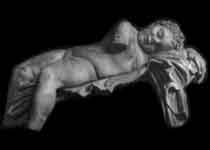

Eros punished by Venus, Pompeii, National Museum, Naples.


Eros - Pompeii, Naples Museum, Italy

Myths associated with Eros
Eros, angry at Apollo for making fun of his archery skills, caused him to fall in love with the nymph Daphne, daughter of Ladon, who had scorned him. Daphne prayed to the river god Peneus to help her and was changed into a laurel tree, which became sacred to Apollo.
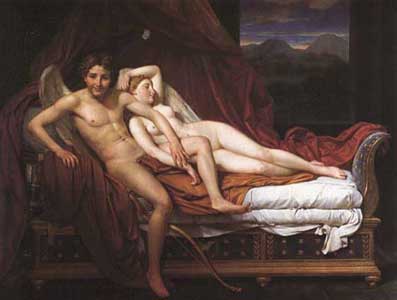
Amor and Psyche, Jacques Louis David (1748-1825)
The story of Cupid and Psyche, first attested in Apuleius' Latin novel, The Golden Ass, recounts the love between Cupid and Psyche, whose name means "soul". Aphrodite was jealous of the beauty of Psyche, a mortal, and asked Cupid to make her fall in love with the ugliest man on earth; instead, Cupid fell in love with her himself and spirited her away to his home. Their peace was ruined by the jealousy of Psyche's sisters, and Psyche was forced to complete a number of trials, including descending to the underworld, in order to be reunited with Cupid. Eventually, she bore him a daughter, Voluptas, whose name means "pleasure", and became immortal herself. Psyche's visit to and return from the underworld made her an object of some devotion, like Dionysus and Persephone. She was an object of some mystery religions and was occasionally mentioned in connection with the popular Eleusinian mysteries.
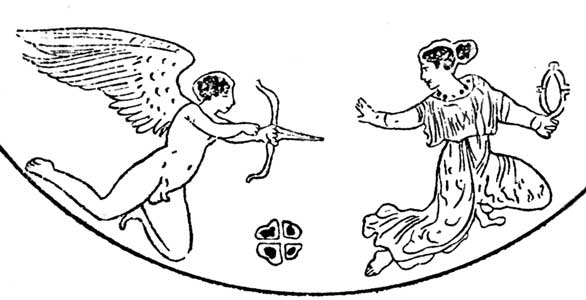
Eros "hunting" a woman
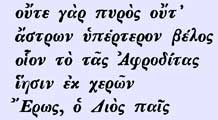
Euripides
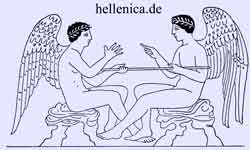
Eros and Anteros playing an ancient Greek Game
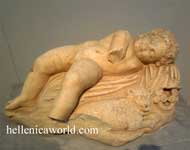
5753 : Statue of a sleeping Eros.
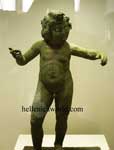
16776 : Infant Eros statuette

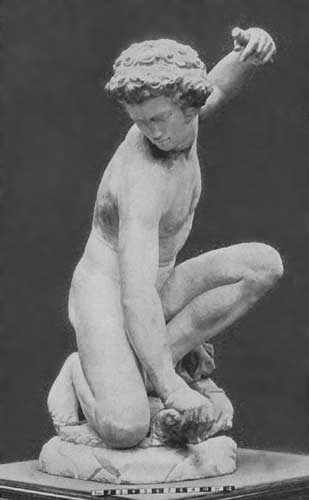
Michelangelo, "Cupid", South Kensington Museum, London

Eros, sculpture, Emil Wolff 1836
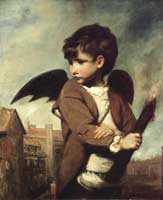
Eros Borghese Louvre Ma235
Botticelli Primavera / Triumph of Spring
"Erotostasia", a young woman weighing Eros and Anteros from the "Erotostasia painter". Dated to ca. 330 BC Inv. no. 12544, National Archaeological Museum of Athens.
Cupid Chastised 1605-10,Bartolomeo Manfredi, c. 1580-1621), Art Institute of Chicago
Eros, Sidney Harold Meteyard (1868-1947)
See also : Greek Mythology. Paintings, Drawings
Greek Mythology Index
A - B - C - D - E - F - G - H - I - J - K - L - M -
N - O - P - Q - R - S - T - U - V - W - X - Y - Z
Α - Β - Γ - Δ - Ε - Ζ - Η - Θ - Ι - Κ - Λ - Μ -
Ν - Ξ - Ο - Π - Ρ - Σ - Τ - Υ - Φ - Χ - Ψ - Ω
| Ancient Greece
Science, Technology , Medicine , Warfare, , Biographies , Life , Cities/Places/Maps , Arts , Literature , Philosophy ,Olympics, Mythology , History , Images Medieval Greece / Byzantine Empire Science, Technology, Arts, , Warfare , Literature, Biographies, Icons, History Modern Greece Cities, Islands, Regions, Fauna/Flora ,Biographies , History , Warfare, Science/Technology, Literature, Music , Arts , Film/Actors , Sport , Fashion --- |
Retrieved from "http://en.wikipedia.org"
All text is available under the terms of the GNU Free Documentation License

